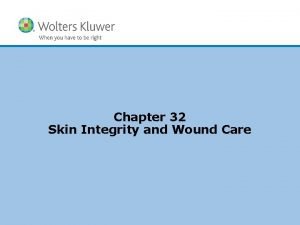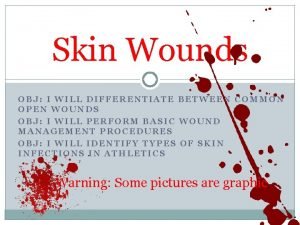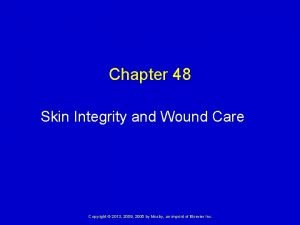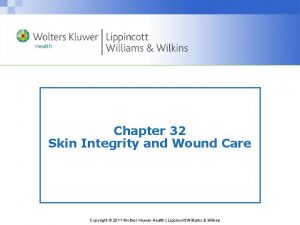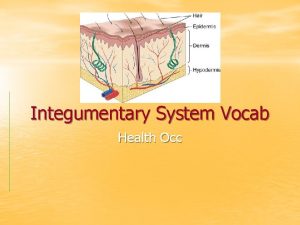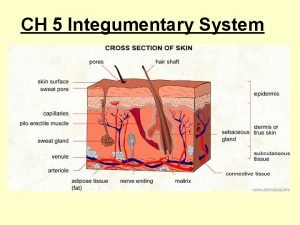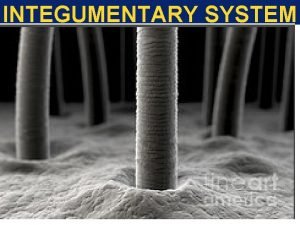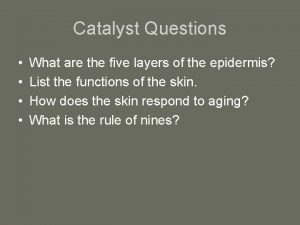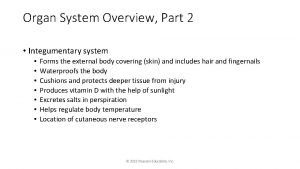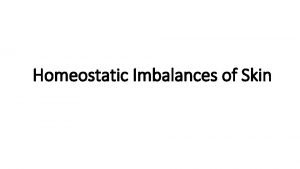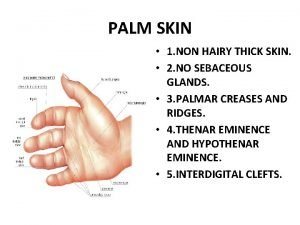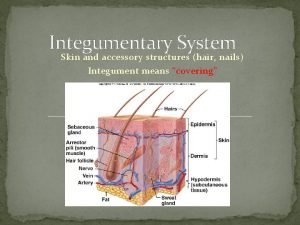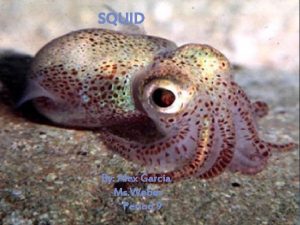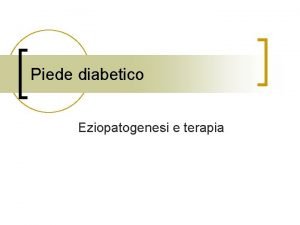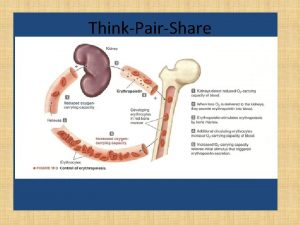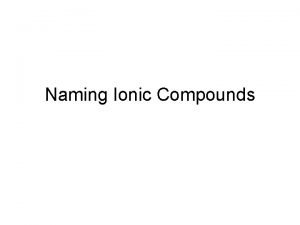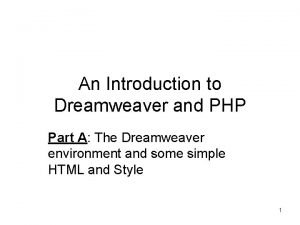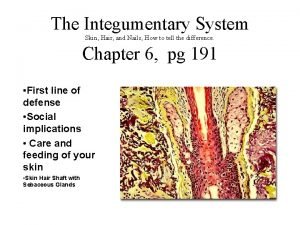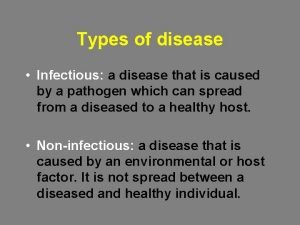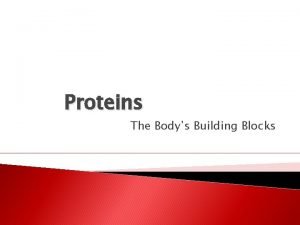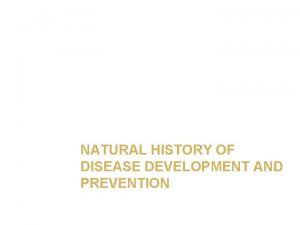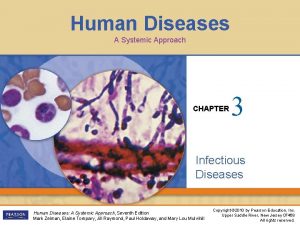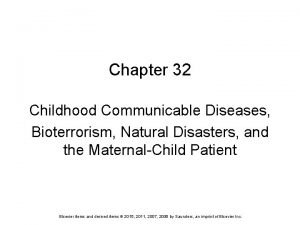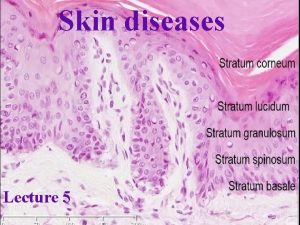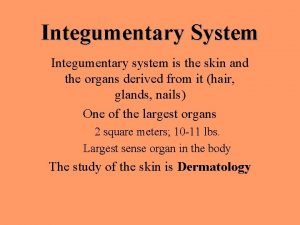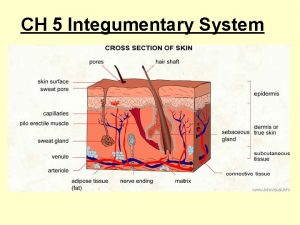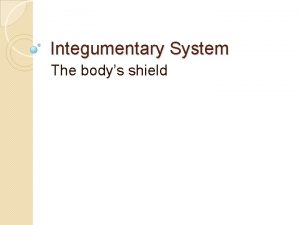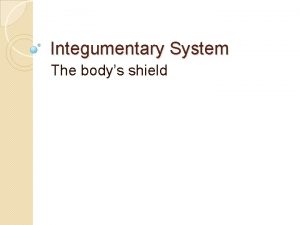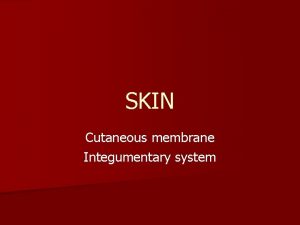The SKIN SELECTED INTEGUMENTARY SYSTEM DISEASES CONDITIONS Wound










































































































































- Slides: 138

The SKIN… SELECTED INTEGUMENTARY SYSTEM DISEASES & CONDITIONS Wound Infections Wound Dehiscence & Evisceration Pressure Ulcers Arterial and Venous Ulcers Skin Cancer Skin Diseases Lesions/Wounds Rashes Herpes Zoster/ Shingles Part I

Trivia Question How many square feet of skin does the average adult have?

Trivia Question How many square feet of skin does the average adult have? Answer: ~ 18 -20 square feet…… 5’ x 4’

Integumentary Diseases Learning Outcomes: 1. Use proper terminology to describe different skin lesions and problems 2. Identify signs of wound infections 3. Describe the ABCD(E) method of assessing skin cancer 4. Identify clients at risk for pressure ulcer development 5. Differentiate between the clinical manifestations for Stage I through Stage IV pressure ulcers, and their treatments. 6. Identify appropriate treatment for prevention of pressure ulcers. 7. Compare the clinical manifestations and modes of transmission for bacterial, viral, and fungal skin infections. 8. Identify the difference between arterial ulcers and insufficiency versus venous stasis ulcers.

Key Terminology angioma carcinoma cellulitis dermatitis atopic dermatitis contact dermatitis eczema edema ecchymosis erythema eschar folliculitis furuncles granulation hemangioma hirsutism hyperbaric oxygen (HBO) keloid lichenification macule melanoma nevus nodule papule paronychia petechiae pressure ulcer pruritis psoriasis purpura pustule vacuum assisted closure (Wound Vac) turgor urticaria vesicle wheal xerosis

Wound Infections Wound Dehiscence & Evisceration Pressure Ulcers Arterial and Venous Ulcers Skin Cancer Skin Diseases Skin Lesions / Wounds Rashes Herpes Zoster/ Shingles

Raised Depressed Flat /Macular Surface Change Fluid Filled Purpura / Vascular Configurations papule plaque nodule cyst comedo keloid horn wheal atrophy erosion ulcer sinus striae burrow poikolderma macule patch erythema erythroderma scale crust excoriation eschar lichenification exfoliation ichthyosiform vesicle bulla pustule abscess furuncle petechiae purpura ecchymosis telangiectasia linear grouped scattered polycyclic reticular serpinginous targetoid whorled arcuate annular “Beauty is Only Skin Deep…”

Raised Depressed Flat /Macular Surface Change Fluid Filled Purpura / Vascular Configurations papule plaque nodule cyst comedo keloid horn wheal atrophy erosion ulcer sinus striae burrow poikolderma macule patch erythema erythroderma scale crust excoriation eschar lichenification exfoliation ichthyosiform vesicle bulla pustule abscess furuncle petechiae purpura ecchymosis telangiectasia linear grouped scattered polycyclic reticular serpinginous targetoid whorled arcuate annular “Beauty is Only Skin Deep…” “But UGLY goes down to the bone!”

Raised Depressed Flat /Macular Surface Change Fluid Filled Purpura / Vascular Configurations papule plaque nodule cyst comedo keloid horn wheal atrophy erosion ulcer sinus striae burrow poikolderma macule patch erythema erythroderma scale crust excoriation eschar lichenification exfoliation ichthyosiform vesicle bulla pustule abscess furuncle petechiae purpura ecchymosis telangiectasia linear grouped scattered polycyclic reticular serpinginous targetoid whorled arcuate annular “Skin Changes” Associated Terminology

Integumentary Diseases Review of anatomy & physiology

Integumentary diseases Skin Function: �Skin, hair, and nails are external structures �Serve a variety of specialized functions �Sebaceous and sweat glands cool and lubricate the body and get rid of wastes �The skin, hair, and nails have many vital functions, but the most important is protection. �Once the skin has been pierced or damaged the body is much more susceptible to infection, even from organisms which would not normally be pathogenic, e. g. , staphylococci.


Integumentary diseases Wound Infections & Risks for infection include any pathophysiological states which cause diminished circulation, poor immune response, or delayed repair of tissues These include: �Radiation or trauma �Poor circulation �Immunosuppression, drug induced or disease induced �Impaired oxygenation �Nutritional deficiencies �Coagulation disorders �Immobility �Diabetes, lupus, and other immunodeficiencies

Integumentary diseases Etiology: THINK – WHAT IS CAUSING THIS? And you might learn how to prevent it For example – If the patient is immobile and starting to break down because they cannot move, how do we prevent the skin from breaking down? If the patient has an immunodeficiency, how do we prevent skin breakdown? If the patient has a nutritional deficiency, how do we promote wound healing?

Diagnostic Procedures and Nursing Interventions Wound Culture and Sensitivity (swab cultures and/or wound biopsies): Definitively identify and quantify wound bacteria. Complete Blood Count (CBC) with Differential: Assess immune response. Blood Cultures: Rule out sepsis. Serum Albumin (normal > 3. 5 g/d. L) and Prealbumin (normal 17 to 40 mg/d. L): Assess nutritional status (low levels indicate malnutrition).

Therapeutic Procedures and Nursing Interventions Vacuum-assisted Wound Closure (Wound-Vac) – continuous low-level negative pressure is applied to a sponge-covered suction tube for several hours. Hyperbaric Oxygen Therapy (HBO / HBOT)– administration of high-pressurized 100% oxygen directly over the wound for 60 to 90 min. Surgical Debridement and / or Wound Grafting – surgical excision of nonviable tissue to promote wound healing and/or grafting of skin from donor sites to clean granulating or freshly excised wound bed.

Integumentary diseases Lesions & Infections Signs and symptoms of infection include: Drainage Odor Abscess Fever Discoloration Heat / warmth at site Edema Erythema Poor healing

Integumentary diseases Lesions & Infections

Integumentary diseases Lesions & Infections

Integumentary diseases Lesions & Infections

Integumentary diseases Lesions & Infections

Integumentary diseases Rashes – is it macular or papular?

Integumentary diseases Rashes – is it macular or papular? This rash is actually vesicular, and is herpes zoster, or viral in origin

Integumentary diseases Rashes – is it macular or papular? This rash is actually vesicular, and is herpes zoster, or viral in origin “chicken pox”

Integumentary diseases Infected hair &/or nails also count These are Beau’s lines






























Integumentary diseases

Integumentary diseases Dehiscence – opening of a wound or surgical site

Integumentary diseases Evisceration – internal body parts (viscera) may protrude through a wound or opening. See below. Eviscerated bowel through a clean stab wound

Integumentary diseases Pressure sites – cause pressure ulcers, the number one risk is immobility and boney prominences



Integumentary diseases Stage I ulcer Defined as non-blanching erythema of intact skin, discoloration of skins with warmth or hardness

Integumentary diseases Stage II Ulcer Defined – partial thickness skin loss involving epidermis and/or dermis layer; the ulcer is superficial and presents clinically as an abrasion, blister or shallow crater. Coccyx

Integumentary diseases Stage III Defined as a full thickness skin loss involving damage or necrosis of subcutaneous tissue which may extend down to , but not through underlying fascia; the ulcer presents clinically as a deep crater with or without undermining or adjacent tissue.

Integumentary diseases Stage IV Defined as full-thickness skin loss with extensive destruction, tissue necrosis, or damage to muscle, bone, or supporting structures Bone visible under damage

Integumentary diseases Venous Stasis Ulcers – no stages Caused by poor circulation and poor venous return (PVD) Peripheral vascular disease

Integumentary diseases Venous Stasis Ulcers – no stages Caused by poor circulation and poor venous return (PVD) Peripheral vascular disease Harder to heal, May need a bypass to restore circulation, in addition to dressings. etc. Edema and discoloration are primary symptoms prior to skin breakdown.

Integumentary diseases Treatments of ulcers #1 = prevention and turning, ROM Dressings and packings, from simple to complex colloids

Integumentary diseases Drug therapy Debridement Diet therapy with vitamins and supplements wound – vacuum (Wound Vac) Hyperbaric oxygenation (HBO) Surgical repair

Integumentary diseases Documentation of ulcers It is necessary to identify any skin damage or breakdown on admission, as if these are missed, the hospital or facility can be liable If it was not documented, it was not done

Integumentary diseases Documentation of ulcers Documentation should include a photograph, measuring the ulcer or wound with a sterile paper tape or circle; the depth, the width, the breadth and the total area involved, and any breaking of the skin, any color and any drainage (including color and odor). Then “stage” it.

Integumentary diseases The ABCDE’s of Skin Cancer: Asymmetry Border Irregularity Color - changes Diameter – increasing (Elevation--variable)

Integumentary diseases A-B-C-D----What is it?

Integumentary diseases Malignant Melanoma - Stage I

Integumentary diseases Malignant Melanoma – an aggressive form of cancer, that is mostly preventable, has a genetic component, and may spread into other systems before it is noticed.

Integumentary diseases Rashes and Lesions – Dermatology, the great mimic- is it bacterial, auto-immune, infected, viral, or parasitic?

Integumentary diseases Psoriasis – an autoimmune disease which causes overstimulation of the keratinocytes in the skin. This can be caused initially by skin trauma, irritation, or stress.

Integumentary diseases Psoriasis – may appear like eczema at first, but the plaques become thicker and widespread. Eczema tends to be lighter and scalier

eczema

psoriasis

Integumentary diseases Psoriasis – can erode and disfigure fingers and toes that are affected

Integumentary diseases Psoriasis Treatments Steroids Topical zinc ointments Topical steroids Tar and oil preparations Ultraviolet light therapy – sunlight often helps

Integumentary diseases Psoriasis Treatments ‘Older’ drugs include methotrexate & cyclosporine to suppress the immune system, but this requires monitoring of liver enzymes. New treatments include monoclonal antibodies (A form of chemotherapy—the ‘-mabs’ i. e. efalizumab (Raptiva) for severe forms

Integumentary diseases Lesions – see handouts of definitions and terms, be able to use these. A rash is a rash…. or is it? Common causes of rashes include Allergic dermatitis, usually localized to the areas of contact, hives Drug reactions, usually all over the body Bacterial infections Viral infections

Integumentary diseases What kind of rash is this? If you can’t tell, describe it. Describe the area as well.

Integumentary diseases ‘Ringworm’ – tinea capitus – a fungal infection

Integumentary diseases Etiology: Systemic or local?

toxic epidermal necrolysis (T. E. N. ) Stevens-Johnson Syndrome

Integumentary diseases ‘Viral rashes’

Integumentary diseases Chicken POX (Herpes Zoster) Note however: Staphlococcus skin infections may look the same

Integumentary diseases

Terminology Appendix Terminology Associated With the Integumentary System

The “ABCDE’s of Skin Cancer” Asymmetry Border Irregularity Color Diameter: ¼ inch <or> 6 mm Elevation

angioma Angiomas : benign tumors that are made up of small blood vessels or lymph vessels. Cherry angiomas Spider angiomas

asymmetric 1. Pertaining to an individual lesion: Unequal shape from side to side. 2. Pertaining to a body distribution: Unequal distribution of lesions on both sides of body.

Beau’s lines Beau's lines Transverse depressions or grooves in the nail plate typically occurring at corresponding positions within each nail plate. Often a sign of a prior severe illness such as malnutrition, a systemic disease, or trauma.

carcinoma Carcinoma refers to an invasive malignant tumor consisting of transformed epithelial cells. Alternatively, it refers to a malignant tumor composed of transformed cells of unknown histogenesis, but which possess specific molecular or histological characteristics that are associated with epithelial cells, such as the production of cytokeratins or intercellular bridges. Carcinoma in situ (CIS) refers to a small, localized focus of carcinoma that has not yet invaded Basal Cell Carcinoma

dermatitis Atopic dermatitis~ atopic dermatitis is a very common, often chronic (long-lasting) skin disease that affects a large percentage of the world's population. It is also called eczema, dermatitis, or atopy. Most commonly, it may be thought of as a type of skin allergy or sensitivity. The atopic dermatitis triad includes asthma, allergies (hay fever), and eczema. There is a known hereditary component of the disease, and it is seen more in some families. The hallmarks of the disease include skin rashes and itching. Contact dermatitis~ Contact dermatitis is an inflammation of the skin caused by direct contact with an irritating substance. Symptoms: Itching (pruritus) of the skin in exposed areas ; Skin redness or inflammation in the exposed area. Treatment: remove irritating exposure; topical corticosteroids.

café’ au lait patch café au lait patch A well circumscribed macule or patch varying from pale brown in lighter skin to dark brown in darker skin patients. The macule or patch may have a serrated or irregular margin.

Clubbing clubbing (Hippocratic fingers, watch-glass nails, drumstick fingers) Transverse and longitudinal over -curvature of the nail plate. The distal digit may have associated enlargement. Lovibond's angle is greater than 180 degrees. Typically associated with chronic hypoxia, e. g in those with congenital heart disease, or COPD. .

Dermal dermal Relating to the layer of skin below the epidermis, but above the panniculus, consisting of papillary and reticular layers and containing blood and lymphatic vessels.

eczema : a general term for many types of skin inflammation, also known as dermatitis. The most common form of eczema is atopic dermatitis (some people use these two terms interchangeably).

edema Edema is swelling that is caused by fluid trapped in your body’s tissues. Edema happens most often in the feet, ankles, and legs. Other parts of the body, such as the face and hands, can also be affected

ecchymosis Extravasation of blood into the skin or mucous membranes forming large macules or patches; flat color changes over time may go from blue-black, to brown-yellow, or green.

excoriation A focal erosion usually due to scratching.

erythema Localized, blanchable redness of the skin or mucous membranes.

eschar An adherent, thick, dry black crust.

folliculitis Folliculitis is inflammation of one or more hair follicles. It can occur anywhere on the skin. Common symptoms include a rash, itching, and pimples or pustules near a hair follicle in the neck, groin , or other areas. . . “Hot Tub Folliculitis”:

furuncle A follicle-centered nodule caused by a suppurative infection characterized by pain, redness, and potentially visible pus. Usually greater than 1 cm in diameter.

hematoma A collection of extravasated blood that is relatively or completely confined within a space. The blood is usually clotted (or partly clotted), and depending on time may manifest various degrees of organization and color.

hirsutism Unwanted, excess hair growth; generally in women.

Hyperbaric oxygen (HBO) Hyperbaric oxygen therapy (HBO) involves the breathing of pure oxygen while in a sealed chamber that has been pressurized at 1 1/2 to 3 times normal atmospheric pressure. used in conventional treatment for decompression sickness (the bends); severe carbon monoxide poisoning; certain kinds of wounds, injuries, and skin infections; delayed radiation injury; and certain bone or brain infections.

keloid A firm, usually elevated, proliferation of scar tissue exceeding the area of the preceding skin injury or wound.

lichenification Thickened skin with accentuated markings usually due to repeated rubbing and scratching of skin.

maceration Softened or broken down skin resulting from prolonged exposure to wetness causing whitening and thickening of the keratin sometimes with redness, oozing, and/or scaling.

macule A flat, generally less than. 5 cm area of skin or mucous membrane with different color from surrounding tissue. Macules may have non-palpable, fine scale.

melanoma Melanoma is a malignant tumor that originates in melanocytes, the cells which produce the pigment melanin that colors our skin, hair, and eyes. The majority of melanomas are black or brown. However, some melanomas are skin-colored, pink, red, purple, blue or white. Melanoma is the most serious form of skin cancer.

nevus Nevus (singular); nevi (plural) 1. Any birthmark. 2. A benign pigmented spot on the skin such as a mole (a cluster of melanocytes and supportive tissue that appears as a tan, brown, or flesh-colored spot on the skin). 3. A benign blood vessel tumor on the skin such as a vascular nevus, a local collection of capillaries of the skin (a strawberry birthmark, stork mark, or port wine stain). From the Latin naevus meaning a body mole, especially a birthmark. The plural of nevus is nevi.

nodule A dermal or subcutaneous firm, well-defined lesion usually greater than. 5 cm in diameter.

papule A discrete, solid, elevated body usually less than. 5 cm in diameter. Papules are further classified by shape, size, color, and surface change.

paronychia Paronychia: Inflammation of the folds of tissue surrounding the nail due to infection. The infection may be bacterial (most commonly, staph or strep species) or fungal. The term "paronychia" is compounded from "para-", next to + the Greek "onyx", nail = next to the nail. Paronychia is synonymous with perionychia.

petechiae Tiny, 1 -2 mm nonblanchable purpuric macules resulting from tiny hemorrhages.

plaque A discrete, solid, elevated body usually broader than it is thick measuring more than. 5 cm in diameter. Plaques may be further classified by shape, size, color, and surface change.

Pressure ulcer …an area of skin that breaks down when you stay in one position for too long without shifting your weight. Pressure ulcers are categorized by severity, from Stage I (earliest signs) to Stage IV (worst): Stage I: A reddened area on the skin that, when pressed, is "nonblanchable" (does not turn white). This indicates that a pressure ulcer is starting to develop. Stage II: The skin blisters or forms an open sore. The area around the sore may be red and irritated. Stage III: The skin breakdown now looks like a crater where there is damage to the tissue below the skin. Stage IV: The pressure ulcer has become so deep that there is damage to the muscle and bone, and sometimes tendons and joints.

pruritis Pruritus is an itch or a sensation that makes a person want to scratch. Pruritus can cause discomfort and be frustrating. If it is severe, it can lead to sleeplessness, anxiety, and depression. The exact cause of an itch is unknown. It is a complex process involving nerves that respond to certain chemicals like histamine that are released in the skin, and the processing of nerve signals in the brain. Pruritus can be a part of skin diseases, internal disorders, or due to faulty processing of the itch sensation within the nervous system.

psoriasis A common skin condition that causes skin redness & irritation. Most persons with psoriasis have thick, red skin with flaky, silver-whit patches called scales. There are five main types of psoriasis. Erythrodermic -- The skin redness is very intense and covers a large area. Guttate -- Small, pink-red spots appear on the skin. Inverse -- Skin redness and irritation occurs in the armpits, groin, and in between overlapping skin. Plaque -- Thick, red patches of skin are covered by flaky, silver-white scales. This is the most common type of psoriasis. Pustular -- White blisters are surrounded by red, irritated skin.

purpura Hemorrhage into skin or mucous membranes which varies in size and ranges in color related to duration. Types of purpura include palpable purpura, ecchymosis, and petechiae.

pustule A circumscribed elevation that contains pus. Pustules are usually less than. 5 cm in diameter.

splinter hemorrhages Dark-red, sometimes black thin longitudinal lines appearing to be within the nail plate or nail bed. The shape of the hemorrhages is due to the longitudinal orientation of nail bed capillaries. Splinter hemorrhages are caused by injury to the nail or by certain drugs and diseases. However, trauma is the most common cause. Splinter hemorrhages resolve spontaneously

symmetric 1. Pertaining to an individual lesion: Equal shape from side to side. 2. Pertaining to a body distribution: Equal distribution of lesions on both sides of body.

striae A flat or atrophic, usually linear, area of skin that may vary in color from pink to red that eventually becomes hypopigmented.

telangiectasia Visible, persistent, dilation of small, superficial cutaneous blood vessels.

ulcer A circumscribed loss of the epidermis and at least upper dermis. Ulcers are further classified by their depth, border, shape, edge, and tissue at its base.

Vacuum assisted closure (Wound VAC) Under negative pressure, V. A. C. Therapy with proprietary V. A. C. Granu. Foam Dressings applies mechanical forces to the wound to create an environment that promotes wound healing. These forces are known as macrostrain and microstrain. Macrostrain: Draws wound edges together Provides direct and complete wound bed contact Evenly distributes negative pressure Removes exudate and infectious materials Microstrain Reduces edema Promotes perfusion Promotes granulation tissue formation by facilitating cell migration and proliferation

vesicle A fluid filled cavity or elevation less than. 5 cm in diameter. Fluid may be clear, serous, hemorrhagic or pusfilled.

turgor Skin turgor test a fold of skin is picked up and then quickly let go. The amount that it will stretch is an indication of its extensibility. The speed with which it returns to a normal position is determined by the degree of hydration of the skin and subcutaneous tissue and the amount of fat in the subcutaneous tissue, e. g. in an animal that is 10 to 12% dehydrated the skin fold will not disappear until 20 to 45 seconds have elapsed. The best place to assess skin turgor on a patient who has been laying in the bed for prolonged amounts of time is: forehead or sternum.

urticaria (“hives”) An edematous, transitory papule or plaque having a ring of erythema known as a flare and surrounded often by a narrow peripheral zone of pallor or vasoconstriction. Also known as a wheal.

wheal Wheal An edematous, transitory papule or plaque having a ring of erythema known as a flare and surrounded often by a narrow peripheral zone of pallor or vasoconstriction. Also known as urticaria.

xerosis Dry flaking skin
 Chapter 8 skin disorders and diseases
Chapter 8 skin disorders and diseases Elsevier
Elsevier Milady chapter 8 skin disorders and diseases
Milady chapter 8 skin disorders and diseases Serosanguineous vs serous
Serosanguineous vs serous Chapter 48 skin integrity and wound care
Chapter 48 skin integrity and wound care Skin wound
Skin wound Copyright
Copyright Chapter 48 skin integrity and wound care
Chapter 48 skin integrity and wound care Thin skin vs thick skin
Thin skin vs thick skin Thin skin vs thick skin
Thin skin vs thick skin Alipidic skin is skin that
Alipidic skin is skin that Glands in integumentary system
Glands in integumentary system Integumentary system vocabulary
Integumentary system vocabulary Integumentary system of swine
Integumentary system of swine Definisi sistem integumen
Definisi sistem integumen Epidermis layers
Epidermis layers Exercise 7 the integumentary system
Exercise 7 the integumentary system Integumentary system vocabulary
Integumentary system vocabulary Integument medical term
Integument medical term The integumentary system
The integumentary system Integumentary system physical examination
Integumentary system physical examination Excretory system analogy
Excretory system analogy Cat integumentary system
Cat integumentary system The integumentary system
The integumentary system Figure 5-1 the components of the integumentary system
Figure 5-1 the components of the integumentary system Effects of aging on the integumentary system
Effects of aging on the integumentary system Section 36-3 the integumentary system
Section 36-3 the integumentary system Integumentary system
Integumentary system Integumentary system
Integumentary system Unit 3 integumentary system a&p chapter 5
Unit 3 integumentary system a&p chapter 5 Homeostatic imbalances of skin
Homeostatic imbalances of skin Dermis microscope
Dermis microscope 6 functions of the integumentary system
6 functions of the integumentary system Anatomy and physiology of psoriasis
Anatomy and physiology of psoriasis Intugementary
Intugementary Integumentary system
Integumentary system Integumentary system
Integumentary system Integumentary system cpt coding guidelines ppt
Integumentary system cpt coding guidelines ppt Duct of merocrine sweat gland
Duct of merocrine sweat gland Integumentary system of vertebrates
Integumentary system of vertebrates Nails integumentary system
Nails integumentary system Integumentary system
Integumentary system Excretory and integumentary system
Excretory and integumentary system Squid integumentary system
Squid integumentary system Integumentary system foldable
Integumentary system foldable Chapter 6 integumentary system
Chapter 6 integumentary system Chapter 6 musculoskeletal system
Chapter 6 musculoskeletal system Chapter 17 reproductive system diseases and disorders
Chapter 17 reproductive system diseases and disorders Chapter 15 nervous system diseases and disorders
Chapter 15 nervous system diseases and disorders 10 diseases of lymphatic system
10 diseases of lymphatic system Cardiovascular system diseases and disorders chapter 8
Cardiovascular system diseases and disorders chapter 8 Capnia medical term
Capnia medical term Diseases of the musculoskeletal system
Diseases of the musculoskeletal system Sperm fructose
Sperm fructose University of texas wound classification system
University of texas wound classification system Chapter 36 skeletal muscular and integumentary systems
Chapter 36 skeletal muscular and integumentary systems Meissner corpuscle
Meissner corpuscle How do you pronounce integumentary
How do you pronounce integumentary Organization of the lymphatic system
Organization of the lymphatic system Qualitative vs quantitative data analysis
Qualitative vs quantitative data analysis Survivorship curve for k selected species
Survivorship curve for k selected species Types of selected response assessment
Types of selected response assessment Quantitative vs qualitative
Quantitative vs qualitative Vba combobox selected item
Vba combobox selected item K selected species survivorship curve
K selected species survivorship curve Example of r selected species
Example of r selected species Ounces of ice cream in a large milkshake
Ounces of ice cream in a large milkshake Word basic
Word basic Dubai population pyramid
Dubai population pyramid Everyone selected to serve on this jury
Everyone selected to serve on this jury Tool to delete selected sprite
Tool to delete selected sprite Selected response tasks
Selected response tasks 8255 parallel communication interface
8255 parallel communication interface Playstation | congratulations, you've been selected!
Playstation | congratulations, you've been selected! Three randomly selected households are surveyed 2 6 7
Three randomly selected households are surveyed 2 6 7 K selection r selection
K selection r selection R-selected species
R-selected species Naming compounds
Naming compounds Marginal distribution
Marginal distribution Gwen harwood selected poems
Gwen harwood selected poems Dreamweaver php tutorials
Dreamweaver php tutorials Hát kết hợp bộ gõ cơ thể
Hát kết hợp bộ gõ cơ thể Frameset trong html5
Frameset trong html5 Bổ thể
Bổ thể Tỉ lệ cơ thể trẻ em
Tỉ lệ cơ thể trẻ em Gấu đi như thế nào
Gấu đi như thế nào Tư thế worms-breton
Tư thế worms-breton Chúa yêu trần thế
Chúa yêu trần thế Các môn thể thao bắt đầu bằng tiếng đua
Các môn thể thao bắt đầu bằng tiếng đua Thế nào là hệ số cao nhất
Thế nào là hệ số cao nhất Các châu lục và đại dương trên thế giới
Các châu lục và đại dương trên thế giới Công của trọng lực
Công của trọng lực Trời xanh đây là của chúng ta thể thơ
Trời xanh đây là của chúng ta thể thơ Cách giải mật thư tọa độ
Cách giải mật thư tọa độ Phép trừ bù
Phép trừ bù độ dài liên kết
độ dài liên kết Các châu lục và đại dương trên thế giới
Các châu lục và đại dương trên thế giới Thơ thất ngôn tứ tuyệt đường luật
Thơ thất ngôn tứ tuyệt đường luật Quá trình desamine hóa có thể tạo ra
Quá trình desamine hóa có thể tạo ra Một số thể thơ truyền thống
Một số thể thơ truyền thống Bàn tay mà dây bẩn
Bàn tay mà dây bẩn Vẽ hình chiếu vuông góc của vật thể sau
Vẽ hình chiếu vuông góc của vật thể sau Biện pháp chống mỏi cơ
Biện pháp chống mỏi cơ đặc điểm cơ thể của người tối cổ
đặc điểm cơ thể của người tối cổ V cc
V cc Vẽ hình chiếu đứng bằng cạnh của vật thể
Vẽ hình chiếu đứng bằng cạnh của vật thể Phối cảnh
Phối cảnh Thẻ vin
Thẻ vin đại từ thay thế
đại từ thay thế điện thế nghỉ
điện thế nghỉ Tư thế ngồi viết
Tư thế ngồi viết Diễn thế sinh thái là
Diễn thế sinh thái là Dot
Dot Số nguyên tố là số gì
Số nguyên tố là số gì Tư thế ngồi viết
Tư thế ngồi viết Lời thề hippocrates
Lời thề hippocrates Thiếu nhi thế giới liên hoan
Thiếu nhi thế giới liên hoan ưu thế lai là gì
ưu thế lai là gì Khi nào hổ mẹ dạy hổ con săn mồi
Khi nào hổ mẹ dạy hổ con săn mồi Khi nào hổ con có thể sống độc lập
Khi nào hổ con có thể sống độc lập Sơ đồ cơ thể người
Sơ đồ cơ thể người Từ ngữ thể hiện lòng nhân hậu
Từ ngữ thể hiện lòng nhân hậu Thế nào là mạng điện lắp đặt kiểu nổi
Thế nào là mạng điện lắp đặt kiểu nổi Sinple columnar
Sinple columnar Type of disease
Type of disease Quality guru
Quality guru Protein deficiency diseases
Protein deficiency diseases Natural history of disease ppt
Natural history of disease ppt Modern lifestyle and hypokinetic diseases
Modern lifestyle and hypokinetic diseases Major nutritional deficiency diseases in emergencies
Major nutritional deficiency diseases in emergencies Tromboflibitis
Tromboflibitis Iceberg phenomenon disease
Iceberg phenomenon disease Human diseases a systemic approach
Human diseases a systemic approach Is hemophilia communicable or noncommunicable
Is hemophilia communicable or noncommunicable Chapter 24 lesson 1 sexually transmitted diseases
Chapter 24 lesson 1 sexually transmitted diseases Classification of periradicular diseases
Classification of periradicular diseases Section 19-3 diseases caused by bacteria and viruses
Section 19-3 diseases caused by bacteria and viruses Chapter 32 childhood communicable diseases bioterrorism
Chapter 32 childhood communicable diseases bioterrorism Chapter 24 sexually transmitted diseases and hiv/aids
Chapter 24 sexually transmitted diseases and hiv/aids



